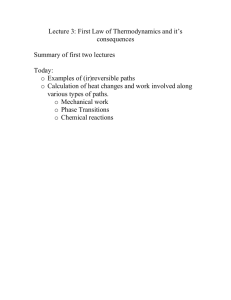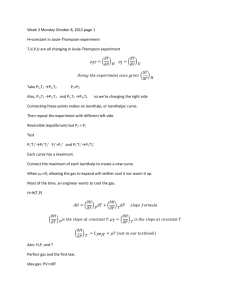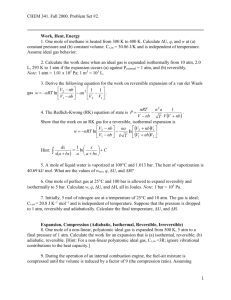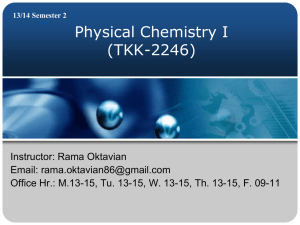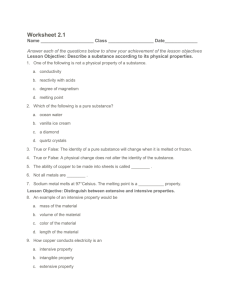Thermodynamics: Lecture 2
advertisement
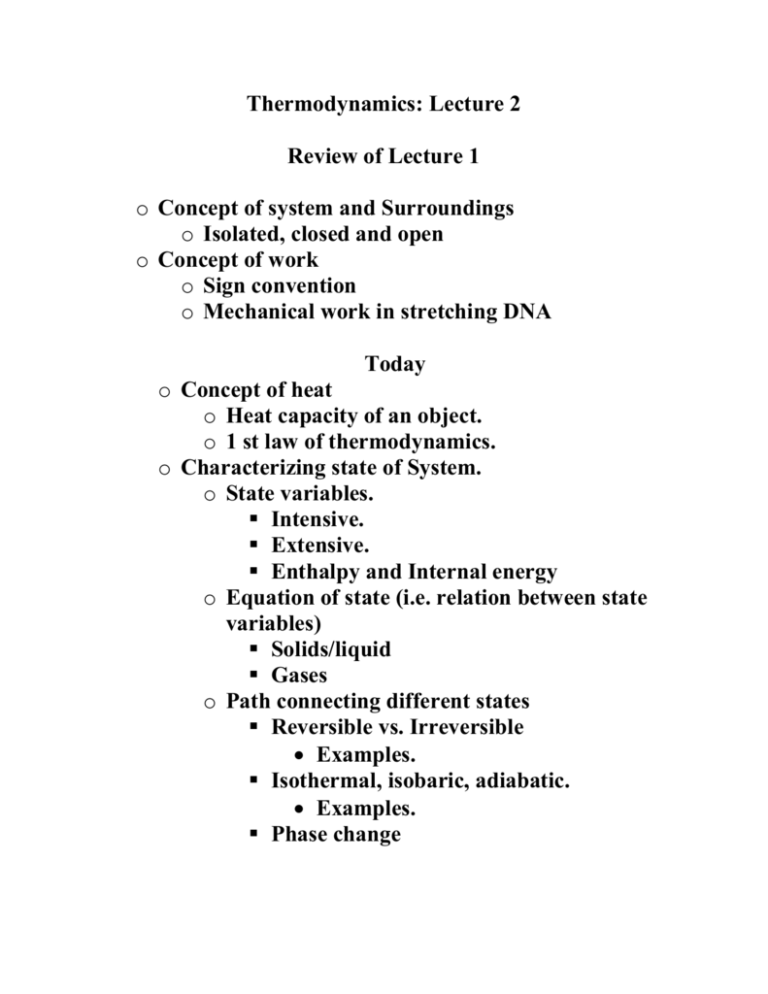
Thermodynamics: Lecture 2 Review of Lecture 1 o Concept of system and Surroundings o Isolated, closed and open o Concept of work o Sign convention o Mechanical work in stretching DNA Today o Concept of heat o Heat capacity of an object. o 1 st law of thermodynamics. o Characterizing state of System. o State variables. Intensive. Extensive. Enthalpy and Internal energy o Equation of state (i.e. relation between state variables) Solids/liquid Gases o Path connecting different states Reversible vs. Irreversible Examples. Isothermal, isobaric, adiabatic. Examples. Phase change Heat When we lift weights or exercise a common sensation is that we feel warm. This sensation of warmth or heat is measured by temperature. Hot coffee becomes lukewarm if we do not drink it quickly. More succinctly, we can say that when two bodies at different temperature when brought in contact will develop identical temperature through exchange of heat. How do we quantify heat? A common observation is that it takes lot more heat to warm water than corresponding volume of air (Think about heating water versus air with a hair dryer). Thus, we measure heat by defining a special quantity, heat capacity. Heat capacity of an object is the amount of heat needed to raise it’s temperature by 1 degree. dq q C dT T Where C is the heat capacity, and q, T are heat and temperature. Since we can only measure temperature we can rewrite: q C.dT C (T2 T1 ) Generally C does not vary much with temperature except near phase transition. T2 and T1 are the final and initial temperatures. So if system cools then the sign of q is negative since it looses heat to surrounding and vice versa. Units of C are J/K. Similarly we can define specific molar heat capacities depending on whether it is measured under conditions of constant pressure or volume. Relation between Work and Heat The first law of thermodynamics. In 1840, Joule performed pioneering set of experiments to show: W Jq Where a direct proportionality between work and heat was established. The conversion factor J, is 4.18Joules/calorie in honor of Joule. Some of his experiments were very simple. He let fixed weight to rotate paddle in water and measured the rise in temperature. Similarly he passed current through resistor and measured the rise in temperature. Now we know that in a closed system, energy can flow in either as work done on the system or as heat flow. If the energy flows into the system it must be provided by surroundings. Otherwise we will have invented a perpetual motion machine. Although different forms of energy may be inter-converted, the first law states that the total energy of system and surroundings is conserved. For a closed system we may therefore write: E q W H. Von Helmhotz stated this in 1847. For isolated system ΔE=0. What about an open system? Characterizing the State of System: State variables So far we have seen how a system in thermodynamics is identified and how different processes such as work or heat can influence it. However to be more specific, we have to identify certain key properties of system. We do that using “state variables”. Easiest way to think of state variables of system is to think of driver’s license. It gives very pertinent information, like date of birth, height, weight and picture etc. Thus, it is useful to decide on what type of information we need to specify about the system. As a first try, we may specify P, V, T, and composition of system to define it specifically. However, we set an important criterion for the selection variables of state: State variables are those variables that only depend on state, and not on how the system arrived at that state. This excludes W the work as a state variable and also q! However E the energy is a state variable! We can also define new state variable by using already known state variables. For example, Enthalpy H E PV A further subdivision of state variables involves on whether they depend on the size of system. Those that depend on the size are called extensive variable, e.g., V,H, E; and those which do not, such as T and P, are called as intensive variables. An extensive variable can be converted to an intensive variable by appropriate division, e.g. density. Equation of State As you can see, we may have too many state variables. One of the ways we can eliminate the redundant variables is through equation of state. Simply stated equation of state represents a relationship between state variables. For example, if our system is made up of ideal gas then we may use PV= nRT as way to eliminate one of the 4 state variables. So to specify the state of an ideal gas we only need 3 state variables. But this process of identifying equation of state is complex and involves approximations, which may not be justified. Therefore, it is essential to experimentally establish an empirical the equation of state as shown in figure 2.3. Once one has an equation of state, we can predict how the state will change as the state variables are changed. However, in practice there are many ways to change the state of a system, some reversible and some irreversible. In thermodynamics, the reversible process are useful in that they allow us to calculate precisely the work, or internal energy changes involved, with aid of the equation of state. Four important reversible paths for gases are (1) isothermal (ΔT=0) (2) Isobaric (ΔP=0) (3) Adiabatic (q=0) (4) Isochoric (ΔV=0) and (5) Cyclic (no change in the state of system). Any irreversible path can be reconstructed using combination of these reversible paths. Example 1 Evaporation of water Path 1: Irreversible path P=1atm n=1mole(l) T=25 P=1atm n= 1 mole (vapor) T=25C Reversibly raise Temperature Reversibly cool. P=1atm n=1 mole(v) T=100C P=1atm n= 1 mole(l) T= 100C Isothermal evaporation Path 2: Vacuum Evaporation P=1atm n= 1 mole(l) T=25 Irreversible path Isothermally Reduce Pressure P=0.001 atm n=1 mole(l) T= 25 C Isothermal evaporation P=1atm n= 1mole (vapor) T=25C Isothermally increase P P=0.001atm n=1mole(vapor) T=25C Note the final result of irreversible evaporation is the same. Whether we boil the water as in example 1, or vacuum evaporate the water as in example 2, the final state of the system is indistinguishable. So what? What is the big Deal? The big deal is that we can calculate the work and heat, and hence the energy changes that occur in any irreversible process by breaking it down in terms of smaller reversible steps. Consider again path 1. Step 1: it is isobaric, and isochoric (volume change is negligible). So the pV work done is 0. ΔE1=q1=CLp(T2-T1), ΔH1=ΔE1. Step 2: This requires us to provide latent heat of evaporation and also it involves a massive change in volume; so pV work is also involved. ΔE2=qL +W= qL –P(VV-VL); ΔH=ΔE2+Δ(PV)= qL Step 3: Involves isobaric cooling. Where only the volume of gas decreases as the vapor is cooled. ΔE3=q3 +W=CVp(T1-T2)-P(VT2-VT1) ; ΔH3=ΔE3+Δ(PV)=q3 This shows how an irreversible process can be broken down in terms of series of reversible processes and hence we can calculate associated changes in the state variables such as energy and enthalpy. More details, general comments We have seen from the above examples how we can calculate the new state of a system when the state variables change. The specific paths we chose such as isothermal, isobaric etc are particularly useful for the calculation of heat and work. From extensive body of thermodynamic work we know (1) The p-V work is negligible if the transformation involves solids or liquid unless we are studying ultra-high pressure systems. (2) In a given phase, e.g., liquid, gas, or solid, the variation in specific heat (Cp or Cv) is essentially negligible over wide ranges of temperature. The only exceptions to this rule are phase transitions such as melting or boiling, where specific heats change dramatically. (3) The p-V work is most significant for gaseous systems. For a system of gas trapped in a cylinder let us consider few specific paths p-V work 1. Isobaric W= -P(V2-V1) …(Expansion) W= +P(V2-V1) …(Compression) P T1 V 2. Isochoric W=0 since there is no change in volume. 3. Isothermal reversible. In this case, to perform reversible work we have to follow the equation of state W P.dV P Ideal Gas Law PV nRT V P T1 V W nRT nRT V V dV nRT ln 2 V V1 For an isothermal rev. process of an ideal gas the change in ΔE=0;q = -W Phase Change During phase transition (liquid-vapor) changes in both heat and work occur. Normally, we study such transition at constant pressure and temperature. (Think of melting point measurement.) For liquid-liquid or solid-liquid or solidsolid phase transition the pV work is negligible, so ΔE=ΔH. This energy goes to rearrange molecular packing in the system. But if phase transition involves gas, (i.e., boiling) there is considerable pV type work. Consider again path 1: P=1atm n=1mole(l) T=25 P=1atm n= 1 mole (vapor) T=25C P=1atm n=1 mole(v) T=100C P=1 atm n= 1 mole(l) T= 100C As we have shown before total energy and enthalpy changes are: ET E1 E 2 E3 & H T H 1 H 2 H 3 ET (C PL C PV )(T2 T1 ) q L P(VTV2 VTL2 ) H T (C PL C PV )(T2 T1 ) q L Note at constant pressure q L H (T2 )
